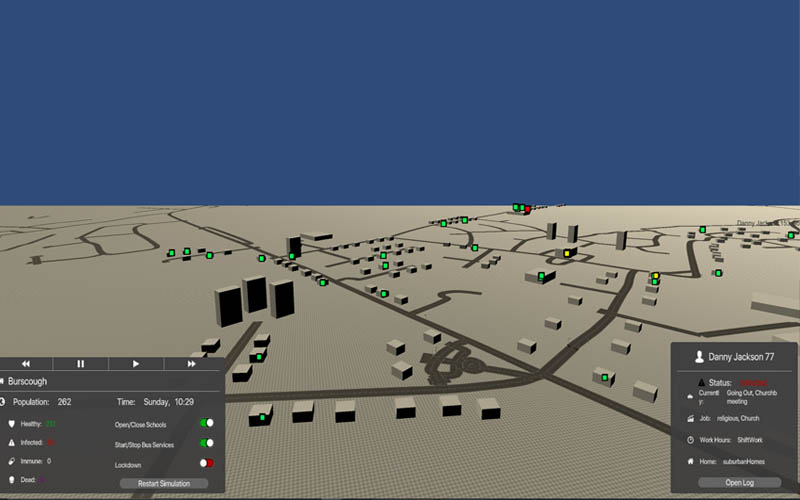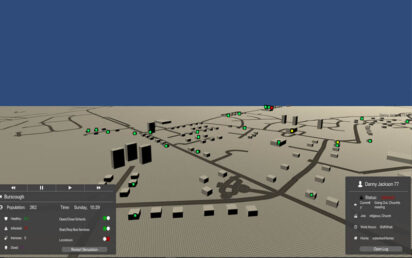Liverpool-based CGA Simulation has won a Government competition from Innovate UK set up to support the design of tech that can help communities get back to normal after COVID-19.
CGA Simulation is a games development and emerging technology studio based at Liverpool’s Baltic Triangle. The company creates games for PC and Mobile and more recently Nintendo Switch.
Its simulations of UK towns and cities have already been used to test the safety of autonomous vehicle technologies, as planning and analysis tools by the military and urban/ crisis planning teams, and as a 5G technology planning tool for Liverpool 5G Health and Social Care.
CGA is now mathematically modelling how Covid19 spreads in local communities using ‘Agent Based Modelling’ (ABM), which focuses on how the virus is transmitted from person to person, in a small town (based on Southport) as people go about their daily business.
The team designed a virtual ‘digital twin’ copy of the town, in which to model community spread of COVID-19, based on simulated interactions between humans, their vehicles and frequently visited buildings and focal points.
This town hub will be used to analyse people’s interactions and likelihood of transmitting the disease as they travel between school, the hairdressers, a bar or church.
The modelling tool the team uses (ABM) differs to that being used by most academic epidemiology researchers, as it assumes each ‘thing’ being modelled has its own ‘agency’, or freewill, to interact independently with the world around it. Other technologies assume the things (vehicles, people) being modelled operate with a hive mind.
Jon Wetherall, Managing Director of CGA Simulation, and simulation modelling expert, explains: “Our technology acknowledges that each person in a community has a different commute to work, school or the gym, different friends and hobbies. Each ‘person’ we model in our digital world makes independent decisions about where they go and what their daily activities are, giving a more realistic view of how people’s movements around a town or a city can impact on disease spread.”
He added: “Modelling that gives us more detailed insights into human/viral interactions would help create ‘combination interventions’. We can model the risks associated with opening up different parts of society: cinemas + school + sports facility, to create mix and match interventions. We would open up and lockdown sections of society, activities or spaces at different times. We can also model risks associated with different numbers of friends and family meeting in groups, inside or outside at any one time, to find out what the upper limit of safer is.”
The CGA team creates ‘living towns’ using real geography via mapping data. ‘Agents’ are created to model the people or cars in the town, commuting to work, going for lunch, or playing football, capturing more complex ‘real world’ interactions.
The algorithms used by CGA’s technology ‘feed’ off the detailed information we now have about how COVID-19 spreads, when and where.
This means it’s used to help identify where local lockdowns would be most useful. The technology can also be used to model the role of ‘super spreaders’ on viral transmission.
COVID-19

